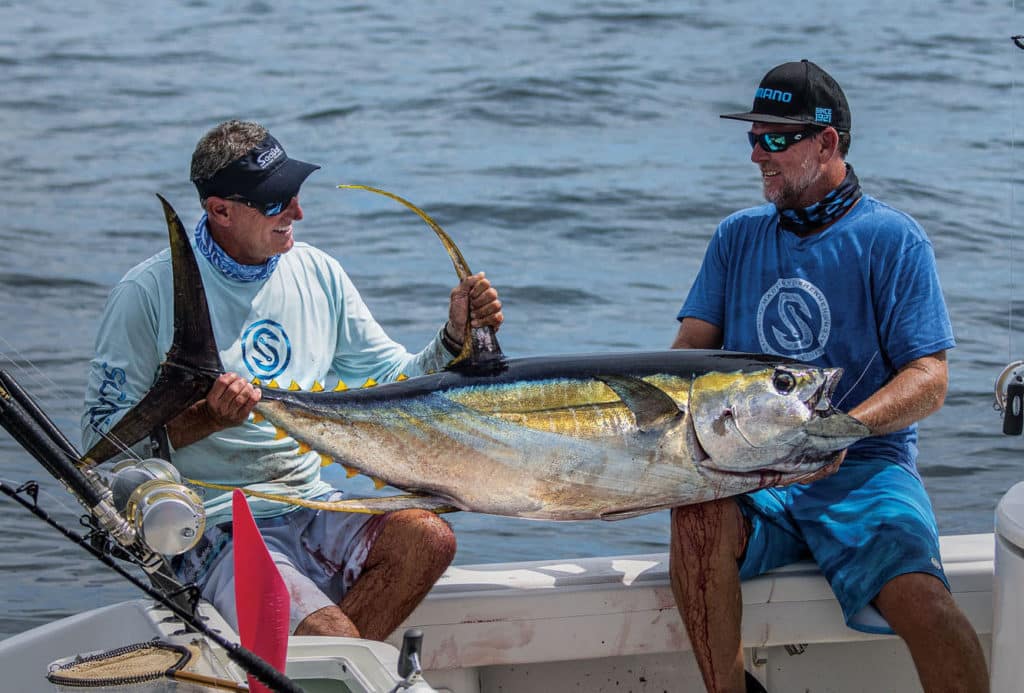
There were 112 miles of ocean stretching between us and our destination. It was around 5 a.m. when we cleared Florida’s St. Lucie Inlet and set a due-east course to Grand Cay, part of the Abaco Islands in The Bahamas. After spending three days in nearby Fort Pierce, waiting for a break in the weather, finally the winds subsided and, with the boat full of fuel, ice and provisions, we were underway.
With me aboard Entropy, the Insetta 45 chosen for our passage, were its owner, Mark Gray, and Jeffrey Spangler and Joel Shine, both with Insetta Boatworks based in St. Marys, Georgia. The boat’s twin hulls sliced gently through the seas at 25 mph. And as the lights of Florida’s Treasure Coast grew distant and the cloudless night sky filled with stars, the resonating drone of the twin Yanmar diesel sterndrives was music to my ears. Ninety minutes later, darkness gave way to the start of a new day. With calm waters ahead, Shine at the controls advanced the throttles a bit to hasten our arrival.
Lay of the Land
Grand Cay is among the northernmost Bahamian outposts. It consists of two keys: Big Grand, a private island, and Little Grand, home to the famous Rosie’s Place, where visiting anglers will find a marina with docking for guests, lodging, a waterfront restaurant, and a bar with a dance floor that past visitors liken to the raucous cantina scene in the original Star Wars movie. Much of Rosie’s Place was rebuilt after the 2004 hurricane season, and it appears the ambience has since become decidedly more docile and family-oriented.
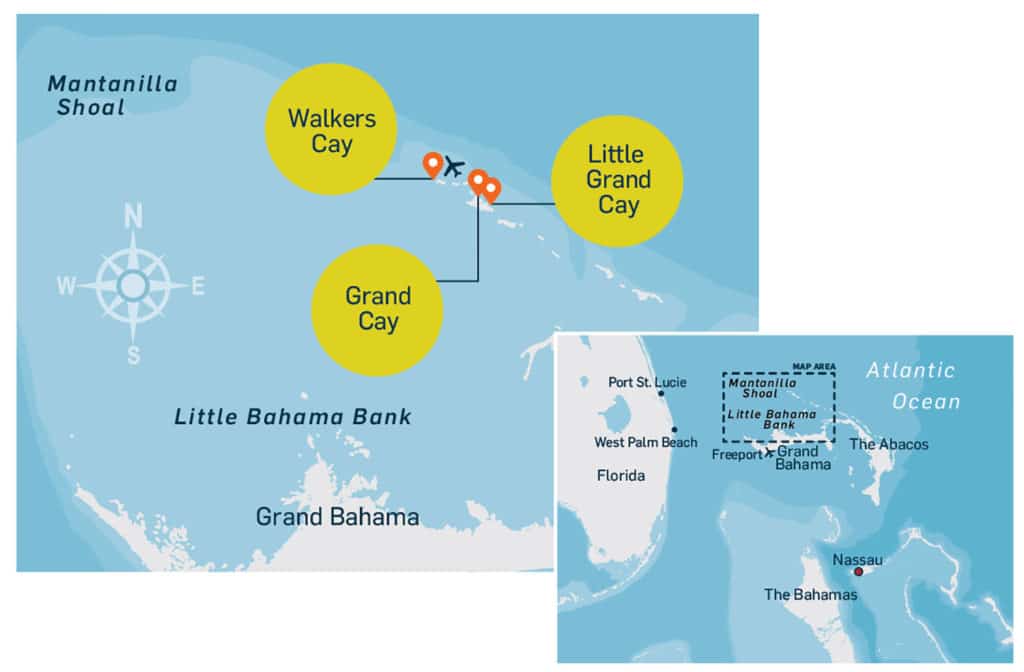
But this trip would be about more than the fishing. And aside from Grand Cay, we planned to visit nearby Walker’s Cay, the once-legendary sport-fishing resort and marina decimated by hurricanes Frances and Jeanne, both in 2004. Efforts to restore Walker’s Cay to its glory-day form are underway, and we wanted to inspect the progress in person.
Trip to the Bank
We reached the western edge of the expansive Little Bahama Bank by 7 a.m., skirted Matanilla Shoal, and -carefully negotiated the waters leading to the Little Grand Cay channel entrance.
After just over a four-hour run, we pulled into the rustic marina at Rosie’s Place, where we were greeted by the dockmaster, who helped us tie up until we cleared customs and obtained a cruising permit, which includes fishing permits, a requirement for all foreign vessels entering Bahamian waters.
In fact, it’s not legal to get off the boat until a customs officer arrives. Within 20 minutes, an official showed up to fill out the paperwork and collect the requisite fees. This stop gave us a chance to pick up Tiko Miller, the local guide we hired to help us navigate the reef-strewn and often treacherous channels, and point us toward some of the most productive fishing areas.
Pelagics to Bottomfish
Not long after, we were back on the move, this time northward through a narrow pass to the submarine precipice where Little Bahama Bank plummets into the depths of the Atlantic.
This drop-off serves as an underwater highway for pelagic game fish. At various times, it’s a prime area for species such as blue marlin, dolphin, yellowfin tuna and wahoo.
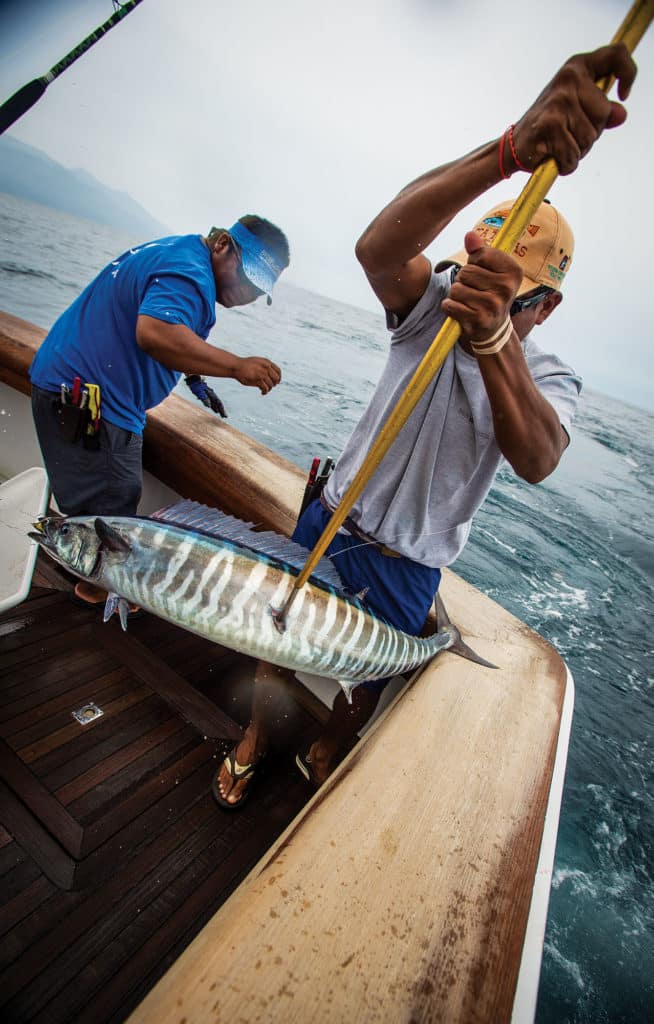
PINAS BAY FISHING JUNE 2014
Upon crossing the drop-off, we spotted a school of breaking skipjacks, a diving gannet and a crashing blue marlin. We quickly set up a trolling spread of lures and skirted ballyhoo off the outriggers and flat lines. But about an hour later, with no bites, we decided to look for grouper.
Miller lined us up for a drift over our target spot in 140 feet of water. But the wind was up, so we were forced to use 16-ounce bucktail jigs—tipped with strips of squid—to reach bottom and overcome the fast drift.
Luckily, results came quickly and, in short order, we had a cooler loaded with small but tasty strawberry grouper and a couple of respectable red grouper, and we went looking for a kicker fish or two to round out our first day at Grand Cay.
Shallow Reef Hogs
At Miller’s suggestion, we tried shallower water for mutton snapper and hogfish. The bases of some Bahamian patch reefs are frequented by large muttons in April, and our guide knew a number of consistent producers. His local knowledge ensured our safe passage through a maze of treacherous reefs until he reached the one he wanted, and we set anchor 90 feet up-current, in water just 25 feet deep.
Miller then baited a circle hook on the end of 40-pound fluorocarbon leader with a glob of squid and let it drift back toward the reef. In a few minutes, we had a bite. Spangler picked up the rod, set the hook, and quickly sensed the fish lacked the shoulders of a mutton. He was right—it was a nice hogfish, and it went into the cooler, destined for dinner that night.
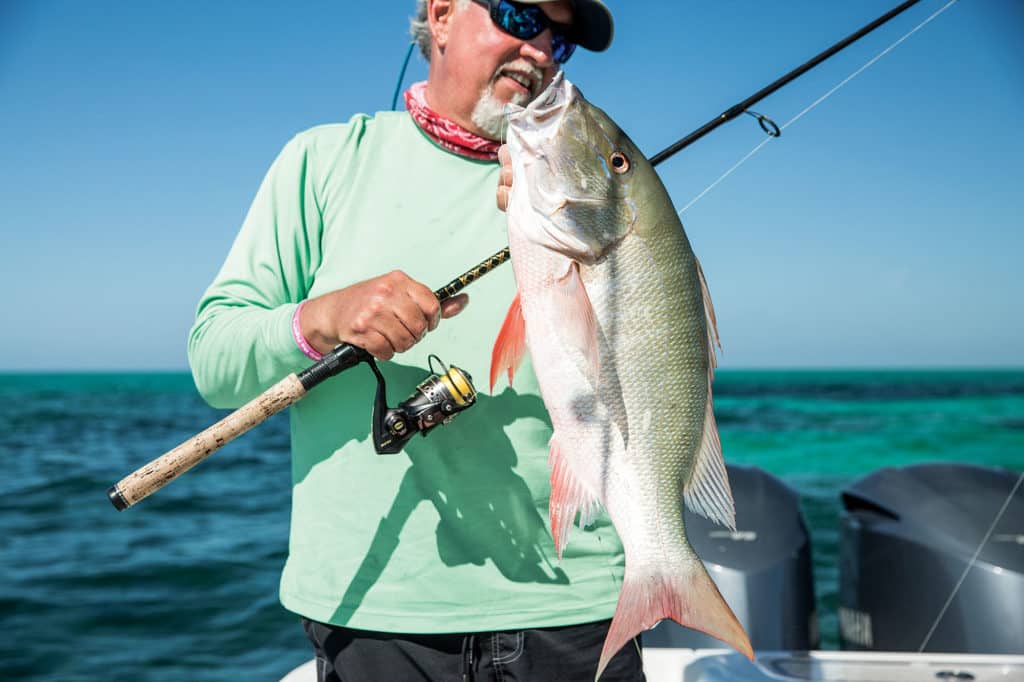
After sending another bait down, Miller left us watching the rod while he put on his mask and fins, and dived for conch. In no time he returned with six, a welcome addition to our dinner menu. And the moment Miller got back on board, we were bit again. This time, Shine was on the reel, and from the start of battle, we could tell this fish was a mutton. Despite several spirited attempts to retreat to the reef, it eventually tired and was put on ice.
At Rosie’s Place that night, we savored the fruits of our efforts, and agreed that two crew would sleep in the motel room and the other two aboard the Insetta. Shine and I chose the boat. He took one of the forward sponson berths, and I settled in on a beanbag inside the spacious center console.
Second Round
Come 6 a.m., Miller was back. So we gathered the troops and headed back to the shallow reef heads. Before long, Gray caught a mutton, his first ever. And hopping from one reef head to another throughout the morning, we added a few hogfish to the cooler before heading out to jig for grouper in the afternoon.
The strawberries bit well again, along with a smattering of reds, but then Spangler hooked something bigger that took him around the boat a few times, refusing to yield. Was it a big black grouper, a goliath or a shark? Unfortunately, the fish chewed through the leader before it came close enough to ID.
After a few more drifts and more fish than we cared to clean, we decided to visit Walker’s Cay, which lies northwest of Grand Cay.
Iconic Key
As we pulled into the marina, a work barge was tied up near the entrance, and pile-driving activity was underway near the basin. But many of the old, crumbling interior concrete seawalls had not yet been cleared or repaired.
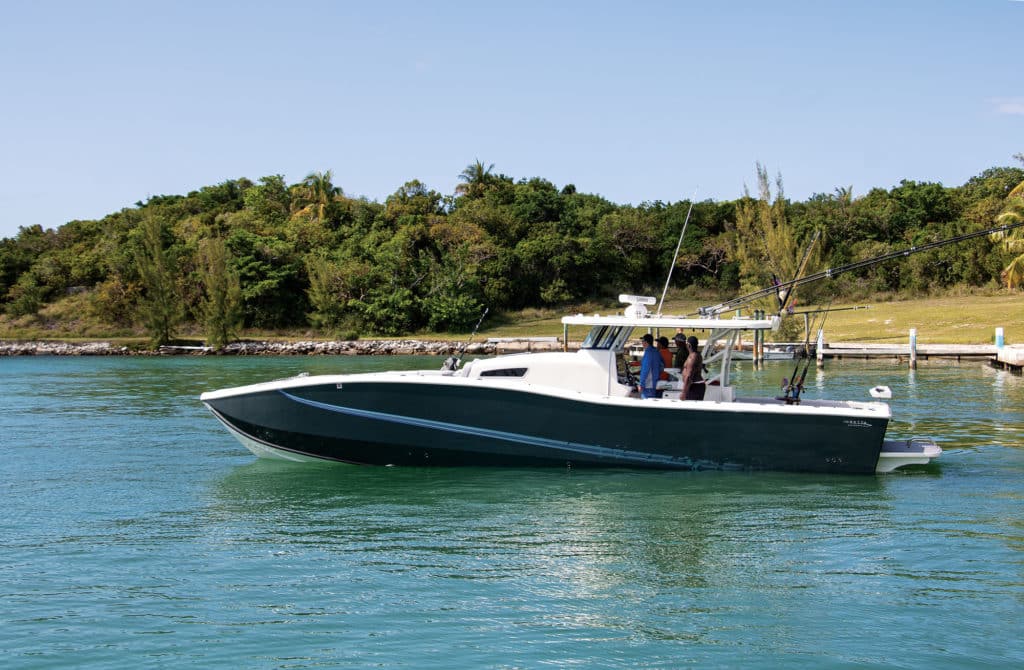
A couple of rickety docks allowed me to go ashore. The airstrip and seaplane ramp seemed to be in good condition, but their use remained reserved for government aircraft. I couldn’t see any construction activity underway on the 69-acre key at the time. However, that was in April 2019, and a good deal of progress has been made since then.
Exit Plan
With the last day of our Bahamas getaway coming to a close, I looked forward to another great meal at Rosie’s Place on the way back to Grand Cay as we made plans for our departure the next morning.
With a 660-gallon fuel capacity and powered by efficient twin diesels, the Insetta 45 didn’t need refueling before heading home, a huge advantage given the high cost of diesel at our chosen Bahamian outpost.
Despite sporty seas during the run back to Florida’s shores, the Insetta’s catamaran hull provided a smooth, dry ride all the way back to Port St. Lucie, where we cleared US Customs.
A comfortable distance from Florida’s Treasure Coast, Grand Cay beckons boating anglers with great fishing, beautiful water, and the typical warmth of the Bahamian people. If you go, tell everyone at Rosie’s Place that Jim sent you.
Grand Cay Trip Logistics
If you wish to reserve a slip or a room at Rosie’s Place in Little Grand Cay, visit rosiesplace.com. You can also call Rosie at 242-727-6051, or email her at rosie@rosiesplace.com. A temporary cruising permit required by Bahamian customs runs $150 for a foreign pleasure boat up to 35 feet, or $300 for larger boats. Good for 90 days, this fee covers the cost of fishing permits for up to three people. Additional fishing permits may be purchased for $20 each for additional anglers. Every crewmember will also need to fill out and sign a date-stamped immigration arrival card. To learn more, visit bahamascustoms.gov.bs/aircraft-and-vessels/cruising-inward-declaration-and-permit.

Walker’s Cay Update
Walker’s Cay resort and marina, about 6 miles northwest of Grand Cay, lived in angling lore for 50 years before hurricanes Florence and Jeanne mauled the 69-acre key in 2004. Closed since 2005, Walker’s Cay is scheduled to rise again thanks to the efforts of new owner Carl A. Allen, founder and CEO of Texas-based Allen Exploration. Hurricane Dorian, in early September 2019, created a 60-day setback in the planned redevelopment of the island. In addition, the COVID-19 pandemic halted the construction progress of Walker’s Cay. As of press time, both The Bahamas and United States had restricted all nonessential commerce in the face of the crisis. Nevertheless, work on the island was scheduled to resume once the restrictions had been lifted.
United States Re-Entry
After visiting a foreign country, including The Bahamas, US federal law requires pleasure boaters to immediately report their return to the United States to US Customs and Border Protection. The easiest way is via the CBP ROAM app (available from the App Store or Google Play), accessible via any smart mobile device. The boat owner inputs biographic information, conveyance and trip details, then submits the trip for review. You’ll receive a push notification and an email with your clearance status as well as any required next steps, if applicable, once a CBP officer reviews the trip. For complete details, visit cbp.gov.









